
Tectona is a genus of tropical hardwood trees in the mint family, Lamiaceae. The three species are often collectively called teak.

Dioscorea oppositifolia is a type of yam (Dioscorea) native to Myanmar (Burma) and to the Indian Subcontinent.

Basilicum is a genus of plants in the Lamiaceae, first described in 1802. It contains only one known species, Basilicum polystachyon, native to Africa, Madagascar, southern Asia, New Guinea, Australia, and various islands of the Pacific and Indian Oceans.

Orthosiphon aristatus is a plant species in the family of Lamiaceae / Labiatae. The plant is a medicinal herb found mainly throughout southern China, the Indian Subcontinent, South East Asia and tropical Queensland. It is known as kumis kucing in Indonesia and misai kucing in Malaysia, both of which translates to cat's whiskers. In the US it may be commonly known as cat's whiskers or Java tea.
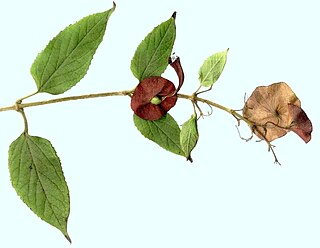
Holmskioldia is a genus of flowering plants in the mint family, Lamiaceae. It is native to the Himalayas but widely cultivated as an ornamental and naturalized in many places It contains only one known species, Holmskioldia sanguinea, commonly called the Chinese hat plant, cup-and-saucer-plant or mandarin's hat.
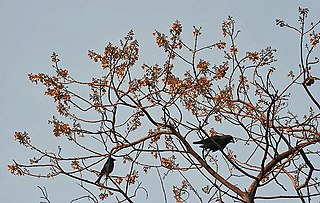
Gmelina is a genus of plants in the family Lamiaceae. It consists of about 35 species in Australia, New Guinea, New Caledonia, Southeast Asia, India and a few in Africa. Some species such as G. arborea have been planted and/or become naturalised in India, Africa and Australia. It was named by Carl Linnaeus in honour of botanist Johann Georg Gmelin.

Ocimum americanum, known as American basil or "hoary basil", is an annual herb with white or lavender flowers. It is used for medicinal purposes. Despite the misleading name, it is native to Africa, the Indian Subcontinent, China, and Southeast Asia. The species is naturalized in Queensland, Christmas Island, and parts of tropical America.

Dendrobium parishii is a species of orchid native to Asia.

Dendrobium fimbriatum, commonly known as 流苏石斛 , is a species of orchid. It is native to China, the Himalayas and Indochina.
Pseudanthistiria is a genus of Asian plants in the grass family.
Myriostachya is a genus of Asian plants in the grass family. The only known species is Myriostachya wightiana, native to India, Bangladesh, Sri Lanka, Myanmar, Thailand, Sumatra, and Peninsular Malaysia.
Acrocercops cylicota is a moth of the family Gracillariidae, known from Karnataka and Maharashtra, India. It was described by Edward Meyrick in 1914. The hostplants for the species include Colebrookea oppositifolia and Elsholtzia fruticosa.

Anisomeles is a genus of herbs of the family Lamiaceae and is native to China, the Indian Subcontinent, Southeast Asia, New Guinea, Australia, Madagascar, and some Pacific and Indian Ocean islands. Plants in the genus Anisomeles have small, flat, narrow elliptic to narrow e.g.-shaped leaves arranged in opposite pairs, the edges of the leaves sometimes wavy or serrated. The flowers are arranged in groups, with five sepals and five petals in two "lips", the lower lip with three lobes, the middle lobe much longer than the side lobes. There are four stamens that extend beyond the petals and a single style in a depression on top of the ovary. The fruit is a schizocarp with four nutlets containing small seeds.

Anisomeles malabarica, the Malabar catmint, is a species of herbaceous plant native to pakisthan, Bangladesh, Sri Lanka, Andaman & Nicobar Islands, Thailand, Malaysia, Indonesia, New Guinea, Bismarck Archipelago, Mauritius, Réunion, northern Australia.

Typhonium flagelliforme is a species of flowering plant in the family Araceae.
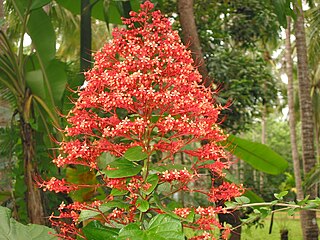
Clerodendrum paniculatum, the pagoda flower, is a species of flowering plant in the genus Clerodendrum and family Lamiaceae. It is native to tropical Asia and Papuasia. It is reportedly naturalized in India, Fiji, French Polynesia, and Central America.

Anisochilus is a genus in the family Lamiaceae, first described in 1830. It is native to China, the Indian Subcontinent, and Indochina.
- Anisochilus adenanthusDalzell & A.Gibson - southern India
- Anisochilus argenteusGamble - southern India
- Anisochilus cambodianusMurata - Thailand, Cambodia
- Anisochilus carnosus(L.f.) Wall. - India, Sri Lanka, Nepal, Himalayas, Bhutan, Assam, Myanmar, Thailand
- Anisochilus dysophylloidesBenth. - Shervarayan Hills in Tamil Nadu
- Anisochilus harmandiiDoan ex Suddee & A.J.Paton - Thailand, Laos, Cambodia
- Anisochilus mitisR.A.Clement - eastern Himalayas
- Anisochilus pallidusWall. - Yunnan, India, Assam, Bangladesh, Laos, Myanmar, Thailand, Vietnam
- Anisochilus paniculatusBenth. - southern India
- Anisochilus plantagineusHook.f. - southern India
- Anisochilus polystachysBenth. - Nepal, Bhutan, Assam, Bangladesh, eastern Himalayas
- Anisochilus robustusHook.f. - southern India
- Anisochilus scaberBenth. - southern India
- Anisochilus siamensisRidl. - Thailand
- Anisochilus suffruticosusWight - southern India
- Anisochilus velutinusTrimen - Sri Lanka
- Anisochilus wightiiHook.f. - southern India
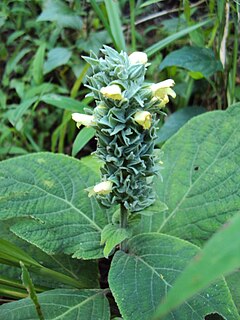
Gomphostemma is a genus of flowering plants in the mint family, Lamiaceae, first described in 1830. It is native to Southeast Asia, China, and the Indian subcontinent.
- Gomphostemma aborensisDunn - Arunachal Pradesh
- Gomphostemma arbusculumC.Y.Wu - Yunnan
- Gomphostemma callicarpoides(Yamam.) Masam. - Taiwan
- Gomphostemma chinenseOliv. - Fujian, Guangdong, Guangxi, Hainan, Jiangxi, Vietnam
- Gomphostemma crinitumWall. ex Benth. - Indochina, Yunnan, Assam, Bangladesh
- Gomphostemma curtisiiPrain - Malaya, Sumatra, Borneo
- Gomphostemma deltodonC.Y.Wu - Yunnan
- Gomphostemma dolichobotrysMerr. - Sumatra
- Gomphostemma eriocarpumBenth. - southern India
- Gomphostemma grandiflorumDoan ex Suddee & A.J.Paton - Vietnam
- Gomphostemma hainanenseC.Y.Wu - Hainan
- Gomphostemma hemsleyanumPrain ex Collett & Hemsl. - Java, Myanmar
- Gomphostemma heyneanumWall. ex Benth. - southern India
- Gomphostemma hirsutumWalsingham - Sabah
- Gomphostemma inopinatumPrain - Myanmar
- Gomphostemma javanicum(Blume) Benth. - Indochina, Andaman Islands, Borneo, Sumatra, Java, Sulawesi, Bali, Lombok, Timor, Philippines
- Gomphostemma keralensisVivek., Gopalan & R.Ansari. - Kerala
- Gomphostemma laceiMukerjee - Myanmar
- Gomphostemma latifoliumC.Y.Wu - Yunnan, Guangdong
- Gomphostemma leptodonDunn - Guangxi, Vietnam
- Gomphostemma lucidumWall. ex Benth. - Indochina, Assam, Bangladesh, Guangdong, Guangxi, Yunnan
- Gomphostemma mastersiiBenth. ex Hook.f. - Assam, Bangladesh, Thailand
- Gomphostemma melissifoliumWall. ex Benth. - Assam, Bangladesh, Bhutan, Nepal
- Gomphostemma microcalyxPrain - Borneo, Malaya, Sumatra
- Gomphostemma microdonDunn - Yunnan, Laos, Thailand, Vietnam
- Gomphostemma nayariiA.S.Chauhan - Assam
- Gomphostemma niveumHook.f. - Assam, Arunachal Pradesh, Vietnam
- Gomphostemma nutansHook.f. - Assam, Myanmar
- Gomphostemma ovatumWall. ex Benth. - Assam, Bangladesh, Bhutan, Nepal
- Gomphostemma parviflorumWall. ex Benth. - Assam, Bangladesh, Bhutan, Nepal, Yunnan, Indochina, Borneo, Java, Sumatra
- Gomphostemma pedunculatumBenth. ex Hook.f. - Assam, Yunnan, Vietnam
- Gomphostemma pseudocrinitumC.Y.Wu - Guangxi
- Gomphostemma salarkhanianumKhanam & M.A.Hassan - Sylhet District in Bangladesh
- Gomphostemma scortechiniiPrain - Myanmar, Thailand, Malaya
- Gomphostemma stellatohirsutumC.Y.Wu - Yunnan
- Gomphostemma strobilinum Wall. ex Benth. - Bangladesh, Myanmar, Thailand, Vietnam
- Gomphostemma sulcatumC.Y.Wu - Yunnan
- Gomphostemma thomsoniiBenth. ex Hook.f. - Assam
- Gomphostemma velutinumBenth. - Assam, Bangladesh
- Gomphostemma wallichiiPrain - Assam, Myanmar, Thailand

Leucosceptrum is a genus of flowering plant in the family Lamiaceae, first described in 1806. It contains only one known species, Leucosceptrum canum, native to south-western China ,the eastern Himalayas, and northern Indochina.
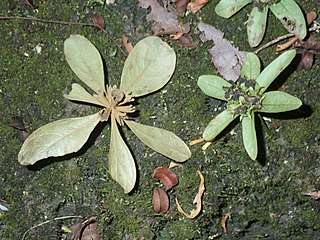
Sphenodesme is a genus of plants in the family Lamiaceae, first described in 1820. The genus is native to southern China, the Indian Subcontinent, Indo-China and Malesia.
















